2011 FORD ESCAPE HYBRID four wheel drive
[x] Cancel search: four wheel drivePage 11 of 363
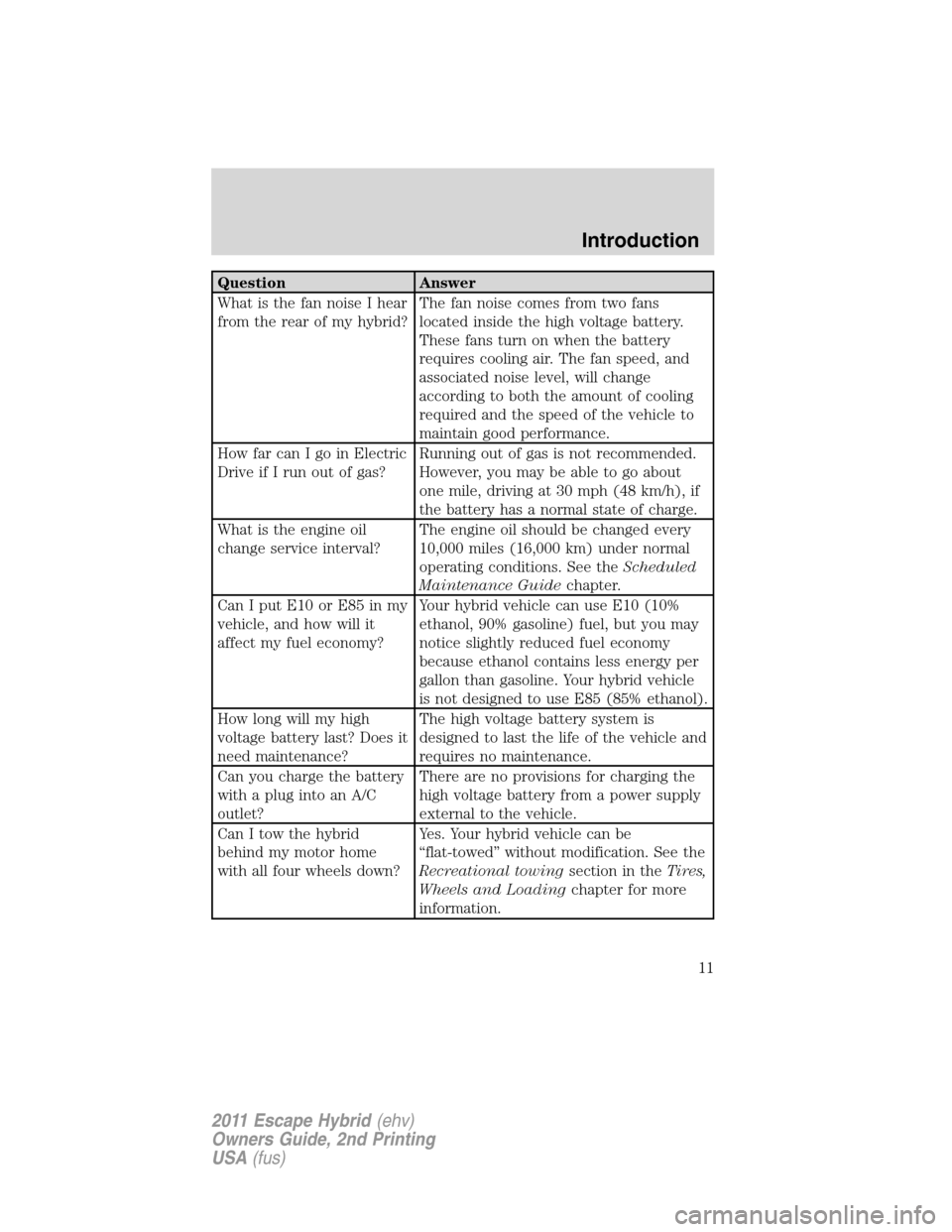
Question Answer
What is the fan noise I hear
from the rear of my hybrid?The fan noise comes from two fans
located inside the high voltage battery.
These fans turn on when the battery
requires cooling air. The fan speed, and
associated noise level, will change
according to both the amount of cooling
required and the speed of the vehicle to
maintain good performance.
How far can I go in Electric
Drive if I run out of gas?Running out of gas is not recommended.
However, you may be able to go about
one mile, driving at 30 mph (48 km/h), if
the battery has a normal state of charge.
What is the engine oil
change service interval?The engine oil should be changed every
10,000 miles (16,000 km) under normal
operating conditions. See theScheduled
Maintenance Guidechapter.
Can I put E10 or E85 in my
vehicle, and how will it
affect my fuel economy?Your hybrid vehicle can use E10 (10%
ethanol, 90% gasoline) fuel, but you may
notice slightly reduced fuel economy
because ethanol contains less energy per
gallon than gasoline. Your hybrid vehicle
is not designed to use E85 (85% ethanol).
How long will my high
voltage battery last? Does it
need maintenance?The high voltage battery system is
designed to last the life of the vehicle and
requires no maintenance.
Can you charge the battery
with a plug into an A/C
outlet?There are no provisions for charging the
high voltage battery from a power supply
external to the vehicle.
Can I tow the hybrid
behind my motor home
with all four wheels down?Yes. Your hybrid vehicle can be
“flat-towed” without modification. See the
Recreational towingsection in theTires,
Wheels and Loadingchapter for more
information.
Introduction
11
2011 Escape Hybrid(ehv)
Owners Guide, 2nd Printing
USA(fus)
Page 176 of 363
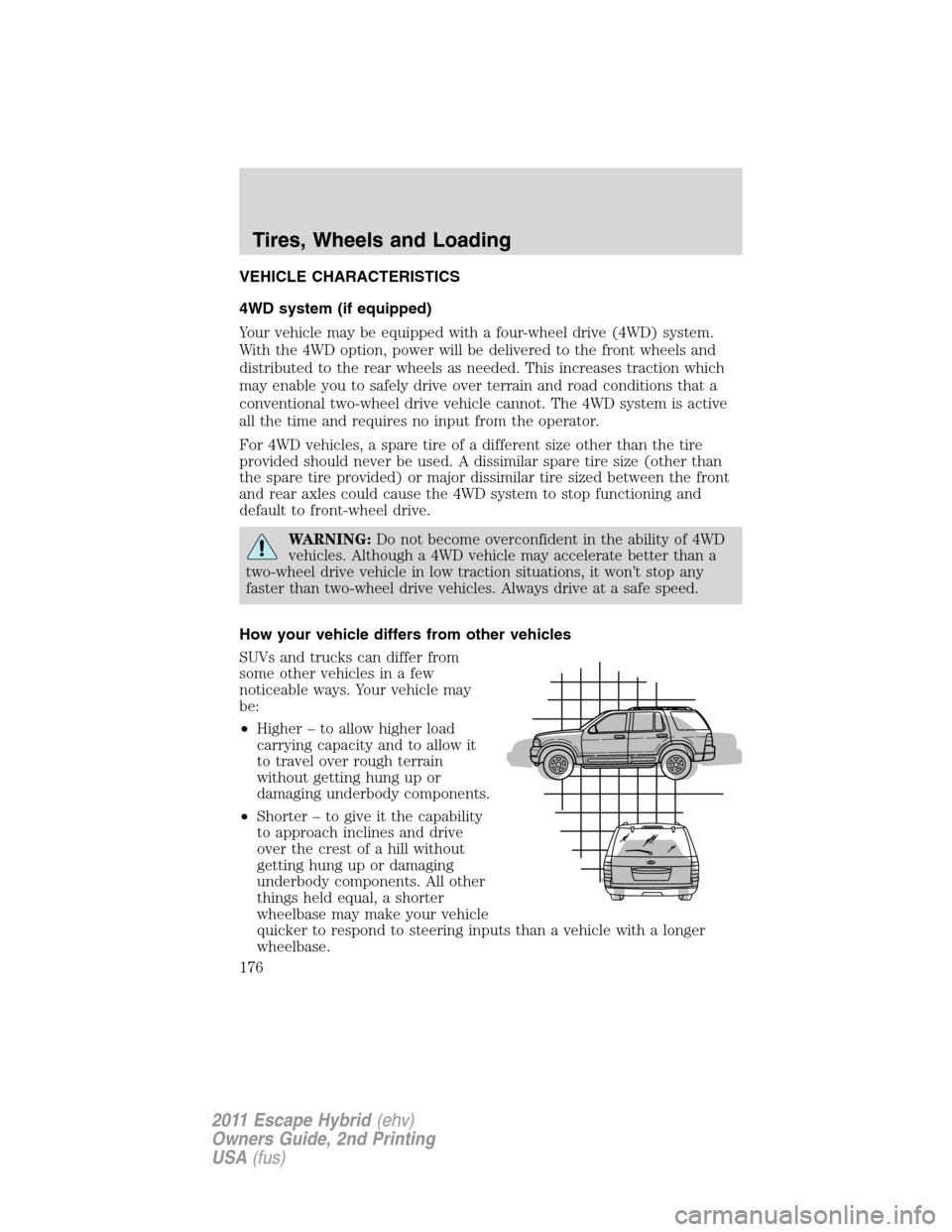
VEHICLE CHARACTERISTICS
4WD system (if equipped)
Your vehicle may be equipped with a four-wheel drive (4WD) system.
With the 4WD option, power will be delivered to the front wheels and
distributed to the rear wheels as needed. This increases traction which
may enable you to safely drive over terrain and road conditions that a
conventional two-wheel drive vehicle cannot. The 4WD system is active
all the time and requires no input from the operator.
For 4WD vehicles, a spare tire of a different size other than the tire
provided should never be used. A dissimilar spare tire size (other than
the spare tire provided) or major dissimilar tire sized between the front
and rear axles could cause the 4WD system to stop functioning and
default to front-wheel drive.
WARNING:Do not become overconfident in the ability of 4WD
vehicles. Although a 4WD vehicle may accelerate better than a
two-wheel drive vehicle in low traction situations, it won’t stop any
faster than two-wheel drive vehicles. Always drive at a safe speed.
How your vehicle differs from other vehicles
SUVs and trucks can differ from
some other vehicles in a few
noticeable ways. Your vehicle may
be:
•Higher – to allow higher load
carrying capacity and to allow it
to travel over rough terrain
without getting hung up or
damaging underbody components.
•Shorter – to give it the capability
to approach inclines and drive
over the crest of a hill without
getting hung up or damaging
underbody components. All other
things held equal, a shorter
wheelbase may make your vehicle
quicker to respond to steering inputs than a vehicle with a longer
wheelbase.
Tires, Wheels and Loading
176
2011 Escape Hybrid(ehv)
Owners Guide, 2nd Printing
USA(fus)
Page 183 of 363
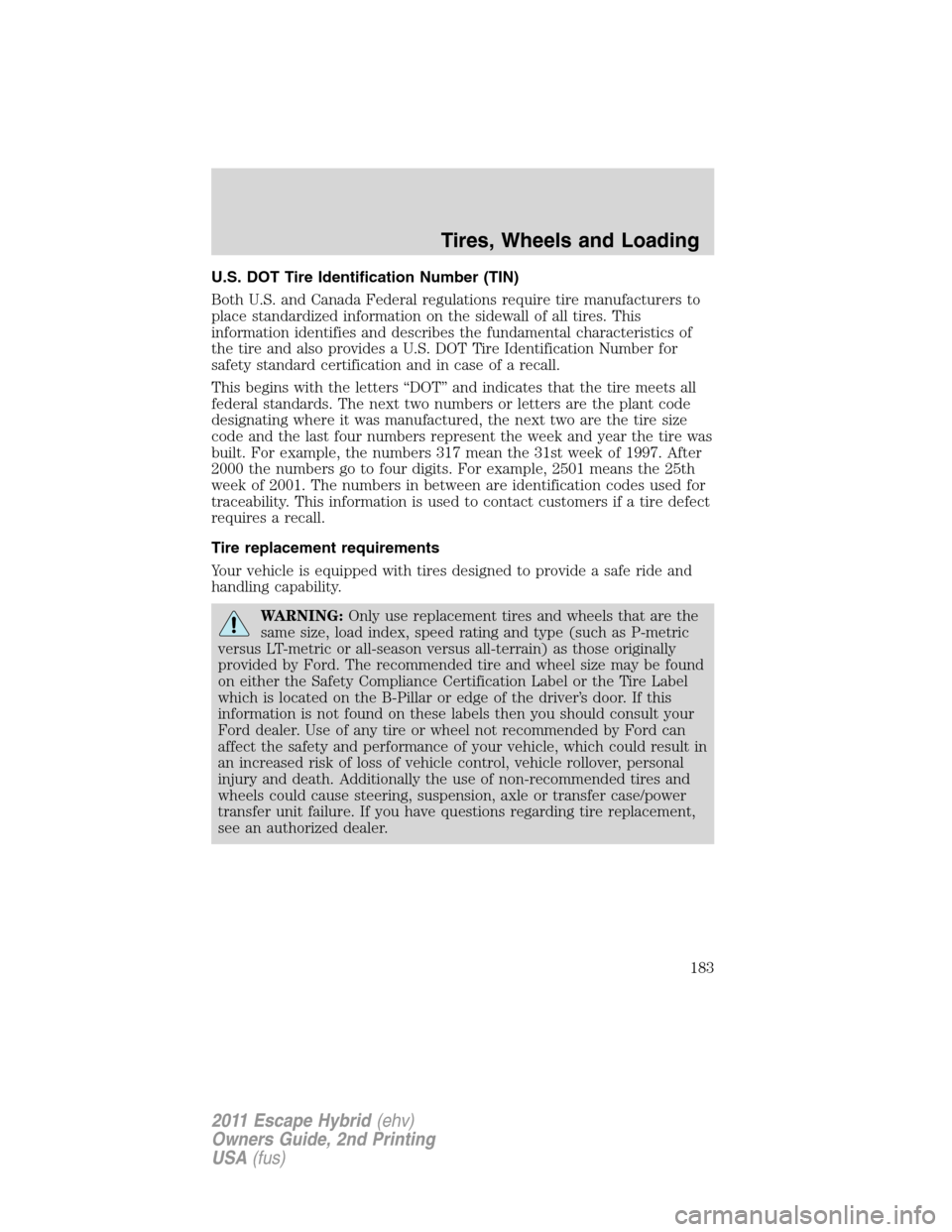
U.S. DOT Tire Identification Number (TIN)
Both U.S. and Canada Federal regulations require tire manufacturers to
place standardized information on the sidewall of all tires. This
information identifies and describes the fundamental characteristics of
the tire and also provides a U.S. DOT Tire Identification Number for
safety standard certification and in case of a recall.
This begins with the letters “DOT” and indicates that the tire meets all
federal standards. The next two numbers or letters are the plant code
designating where it was manufactured, the next two are the tire size
code and the last four numbers represent the week and year the tire was
built. For example, the numbers 317 mean the 31st week of 1997. After
2000 the numbers go to four digits. For example, 2501 means the 25th
week of 2001. The numbers in between are identification codes used for
traceability. This information is used to contact customers if a tire defect
requires a recall.
Tire replacement requirements
Your vehicle is equipped with tires designed to provide a safe ride and
handling capability.
WARNING:Only use replacement tires and wheels that are the
same size, load index, speed rating and type (such as P-metric
versus LT-metric or all-season versus all-terrain) as those originally
provided by Ford. The recommended tire and wheel size may be found
on either the Safety Compliance Certification Label or the Tire Label
which is located on the B-Pillar or edge of the driver’s door. If this
information is not found on these labels then you should consult your
Ford dealer. Use of any tire or wheel not recommended by Ford can
affect the safety and performance of your vehicle, which could result in
an increased risk of loss of vehicle control, vehicle rollover, personal
injury and death. Additionally the use of non-recommended tires and
wheels could cause steering, suspension, axle or transfer case/power
transfer unit failure. If you have questions regarding tire replacement,
see an authorized dealer.
Tires, Wheels and Loading
183
2011 Escape Hybrid(ehv)
Owners Guide, 2nd Printing
USA(fus)
Page 186 of 363
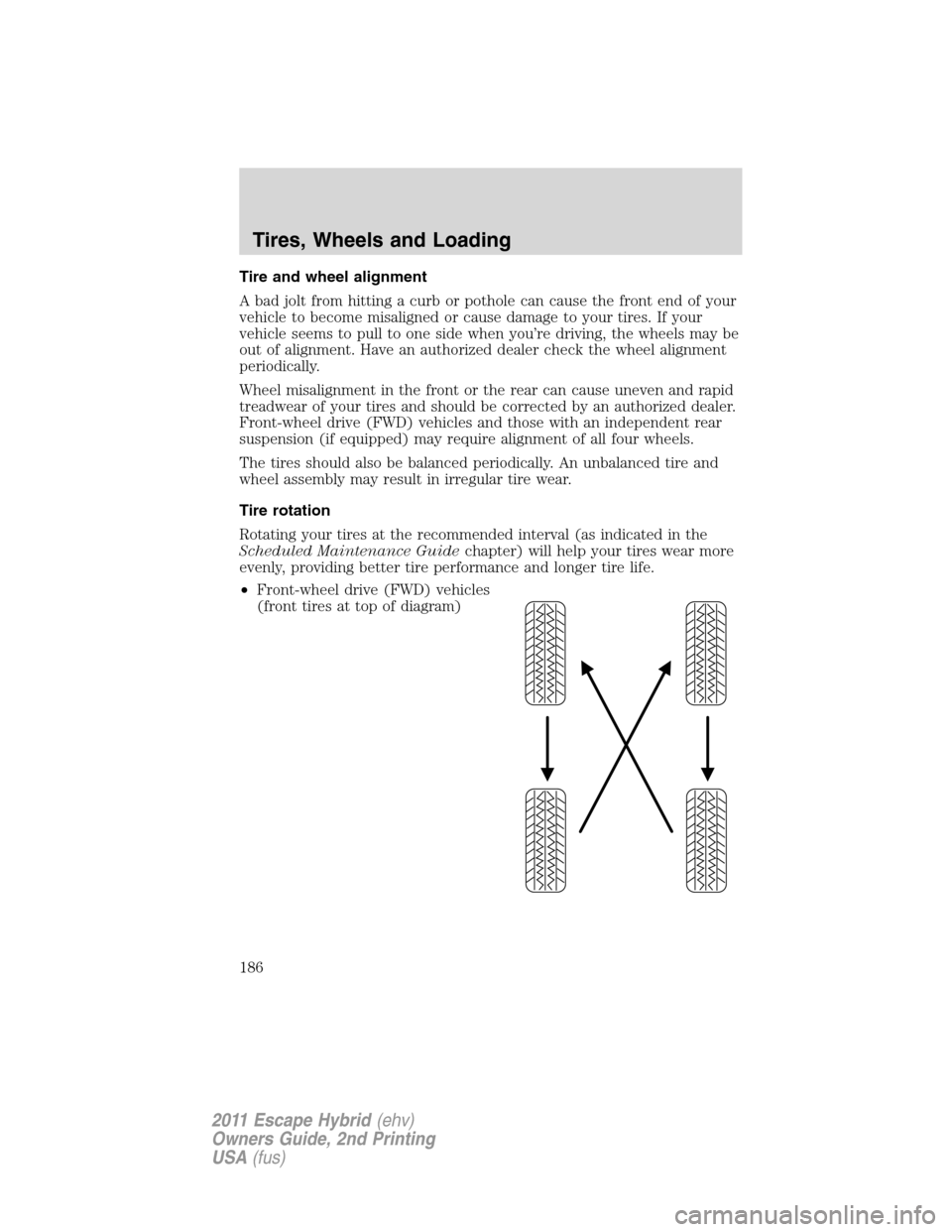
Tire and wheel alignment
A bad jolt from hitting a curb or pothole can cause the front end of your
vehicle to become misaligned or cause damage to your tires. If your
vehicle seems to pull to one side when you’re driving, the wheels may be
out of alignment. Have an authorized dealer check the wheel alignment
periodically.
Wheel misalignment in the front or the rear can cause uneven and rapid
treadwear of your tires and should be corrected by an authorized dealer.
Front-wheel drive (FWD) vehicles and those with an independent rear
suspension (if equipped) may require alignment of all four wheels.
The tires should also be balanced periodically. An unbalanced tire and
wheel assembly may result in irregular tire wear.
Tire rotation
Rotating your tires at the recommended interval (as indicated in the
Scheduled Maintenance Guidechapter) will help your tires wear more
evenly, providing better tire performance and longer tire life.
•Front-wheel drive (FWD) vehicles
(front tires at top of diagram)
Tires, Wheels and Loading
186
2011 Escape Hybrid(ehv)
Owners Guide, 2nd Printing
USA(fus)
Page 187 of 363
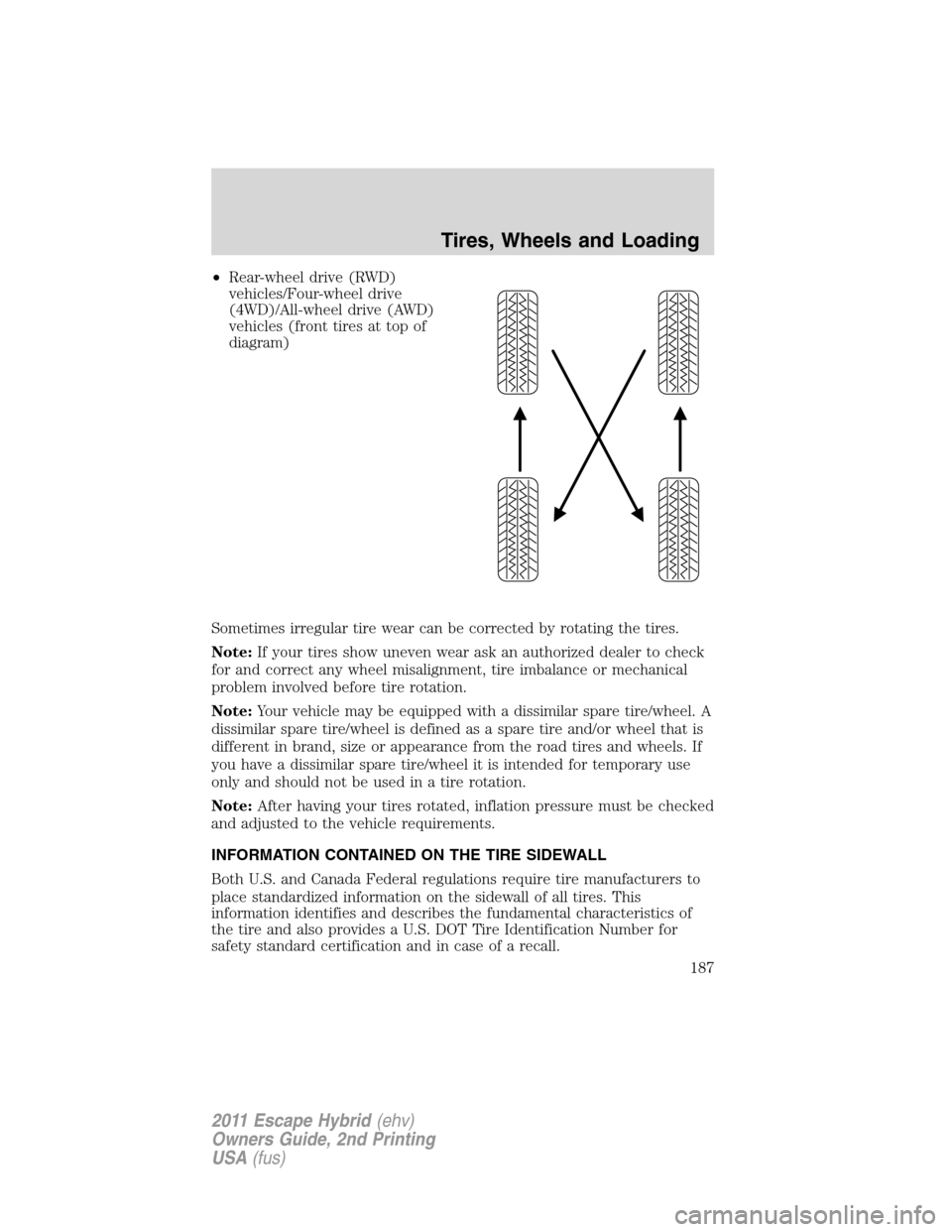
•Rear-wheel drive (RWD)
vehicles/Four-wheel drive
(4WD)/All-wheel drive (AWD)
vehicles (front tires at top of
diagram)
Sometimes irregular tire wear can be corrected by rotating the tires.
Note:If your tires show uneven wear ask an authorized dealer to check
for and correct any wheel misalignment, tire imbalance or mechanical
problem involved before tire rotation.
Note:Your vehicle may be equipped with a dissimilar spare tire/wheel. A
dissimilar spare tire/wheel is defined as a spare tire and/or wheel that is
different in brand, size or appearance from the road tires and wheels. If
you have a dissimilar spare tire/wheel it is intended for temporary use
only and should not be used in a tire rotation.
Note:After having your tires rotated, inflation pressure must be checked
and adjusted to the vehicle requirements.
INFORMATION CONTAINED ON THE TIRE SIDEWALL
Both U.S. and Canada Federal regulations require tire manufacturers to
place standardized information on the sidewall of all tires. This
information identifies and describes the fundamental characteristics of
the tire and also provides a U.S. DOT Tire Identification Number for
safety standard certification and in case of a recall.
Tires, Wheels and Loading
187
2011 Escape Hybrid(ehv)
Owners Guide, 2nd Printing
USA(fus)
Page 189 of 363
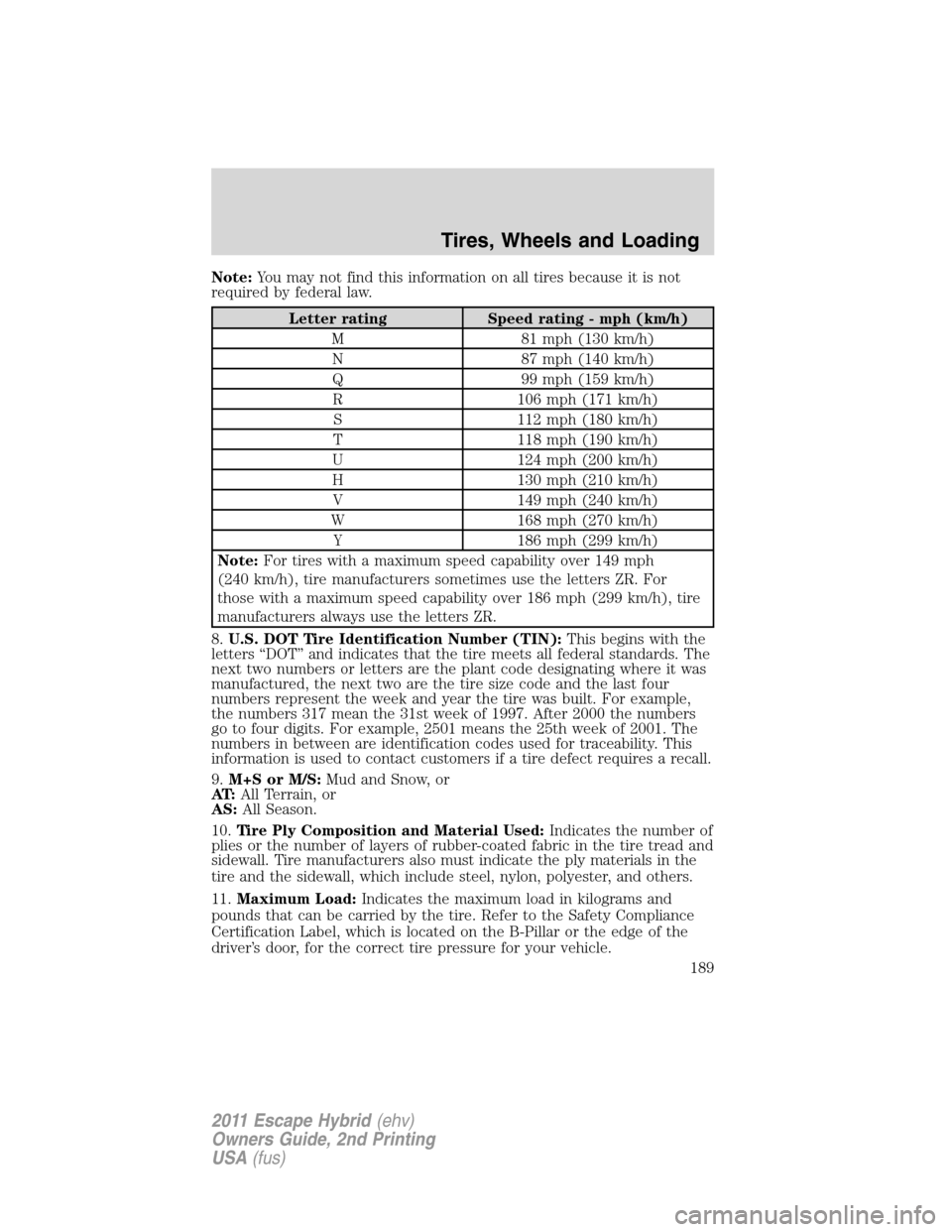
Note:You may not find this information on all tires because it is not
required by federal law.
Letter rating Speed rating - mph (km/h)
M 81 mph (130 km/h)
N 87 mph (140 km/h)
Q 99 mph (159 km/h)
R 106 mph (171 km/h)
S 112 mph (180 km/h)
T 118 mph (190 km/h)
U 124 mph (200 km/h)
H 130 mph (210 km/h)
V 149 mph (240 km/h)
W 168 mph (270 km/h)
Y 186 mph (299 km/h)
Note:For tires with a maximum speed capability over 149 mph
(240 km/h), tire manufacturers sometimes use the letters ZR. For
those with a maximum speed capability over 186 mph (299 km/h), tire
manufacturers always use the letters ZR.
8.U.S. DOT Tire Identification Number (TIN):This begins with the
letters “DOT” and indicates that the tire meets all federal standards. The
next two numbers or letters are the plant code designating where it was
manufactured, the next two are the tire size code and the last four
numbers represent the week and year the tire was built. For example,
the numbers 317 mean the 31st week of 1997. After 2000 the numbers
go to four digits. For example, 2501 means the 25th week of 2001. The
numbers in between are identification codes used for traceability. This
information is used to contact customers if a tire defect requires a recall.
9.M+S or M/S:Mud and Snow, or
AT:All Terrain, or
AS:All Season.
10.Tire Ply Composition and Material Used:Indicates the number of
plies or the number of layers of rubber-coated fabric in the tire tread and
sidewall. Tire manufacturers also must indicate the ply materials in the
tire and the sidewall, which include steel, nylon, polyester, and others.
11.Maximum Load:Indicates the maximum load in kilograms and
pounds that can be carried by the tire. Refer to the Safety Compliance
Certification Label, which is located on the B-Pillar or the edge of the
driver’s door, for the correct tire pressure for your vehicle.
Tires, Wheels and Loading
189
2011 Escape Hybrid(ehv)
Owners Guide, 2nd Printing
USA(fus)
Page 204 of 363
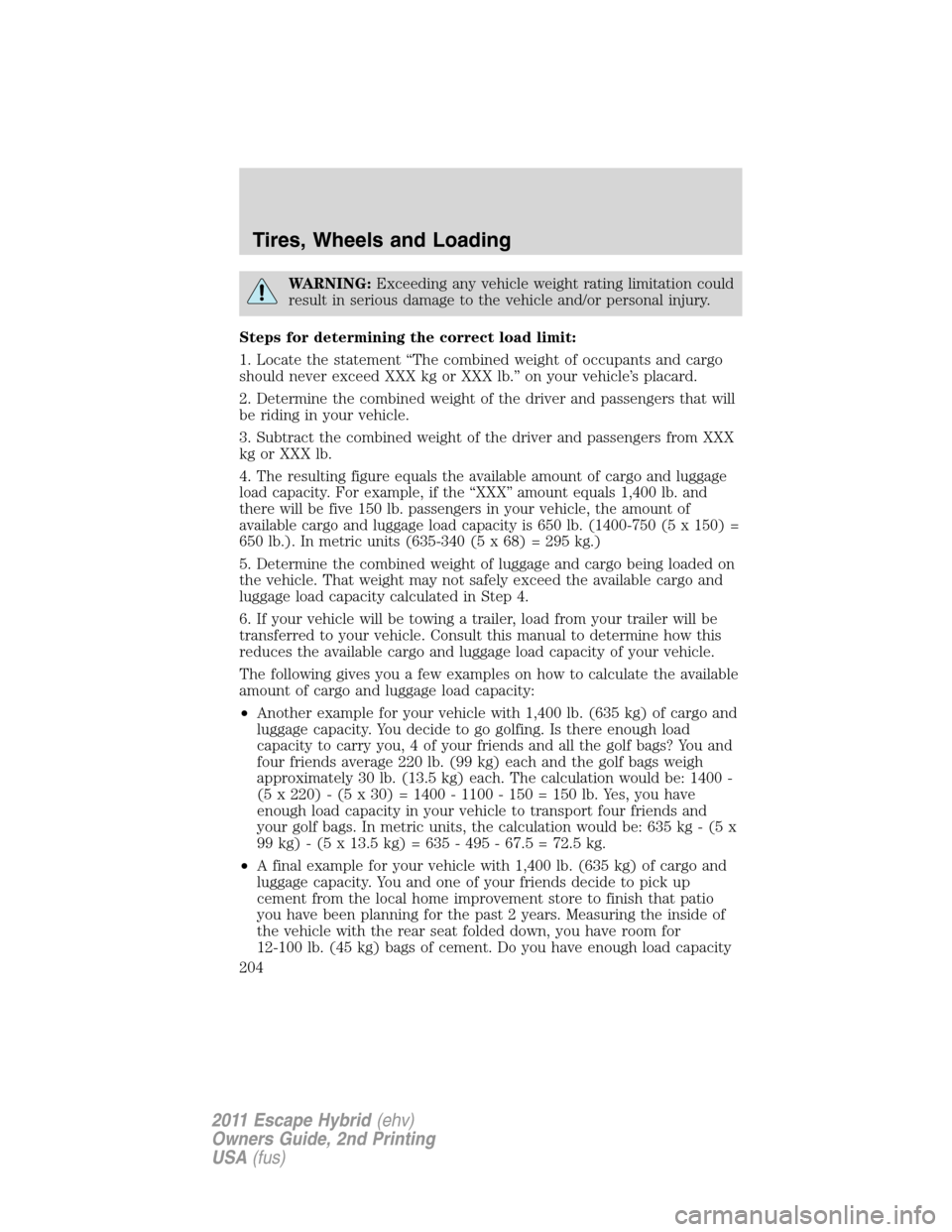
WARNING:Exceeding any vehicle weight rating limitation could
result in serious damage to the vehicle and/or personal injury.
Steps for determining the correct load limit:
1. Locate the statement “The combined weight of occupants and cargo
should never exceed XXX kg or XXX lb.” on your vehicle’s placard.
2. Determine the combined weight of the driver and passengers that will
be riding in your vehicle.
3. Subtract the combined weight of the driver and passengers from XXX
kg or XXX lb.
4.
The resulting figure equals the available amount of cargo and luggage
load capacity. For example, if the “XXX” amount equals 1,400 lb. and
there will be five 150 lb. passengers in your vehicle, the amount of
available cargo and luggage load capacity is 650 lb. (1400-750 (5 x 150) =
650 lb.). In metric units (635-340 (5 x 68) = 295 kg.)
5. Determine the combined weight of luggage and cargo being loaded on
the vehicle. That weight may not safely exceed the available cargo and
luggage load capacity calculated in Step 4.
6. If your vehicle will be towing a trailer, load from your trailer will be
transferred to your vehicle. Consult this manual to determine how this
reduces the available cargo and luggage load capacity of your vehicle.
The following gives you a few examples on how to calculate the available
amount of cargo and luggage load capacity:
•Another example for your vehicle with 1,400 lb. (635 kg) of cargo and
luggage capacity. You decide to go golfing. Is there enough load
capacity to carry you, 4 of your friends and all the golf bags? You and
four friends average 220 lb. (99 kg) each and the golf bags weigh
approximately 30 lb. (13.5 kg) each. The calculation would be: 1400 -
(5 x 220) - (5 x 30) = 1400 - 1100 - 150 = 150 lb. Yes, you have
enough load capacity in your vehicle to transport four friends and
your golf bags. In metric units, the calculation would be: 635 kg - (5 x
99 kg) - (5 x 13.5 kg) = 635 - 495 - 67.5 = 72.5 kg.
•A final example for your vehicle with 1,400 lb. (635 kg) of cargo and
luggage capacity. You and one of your friends decide to pick up
cement from the local home improvement store to finish that patio
you have been planning for the past 2 years. Measuring the inside of
the vehicle with the rear seat folded down, you have room for
12-100 lb. (45 kg) bags of cement. Do you have enough load capacity
Tires, Wheels and Loading
204
2011 Escape Hybrid(ehv)
Owners Guide, 2nd Printing
USA(fus)
Page 210 of 363
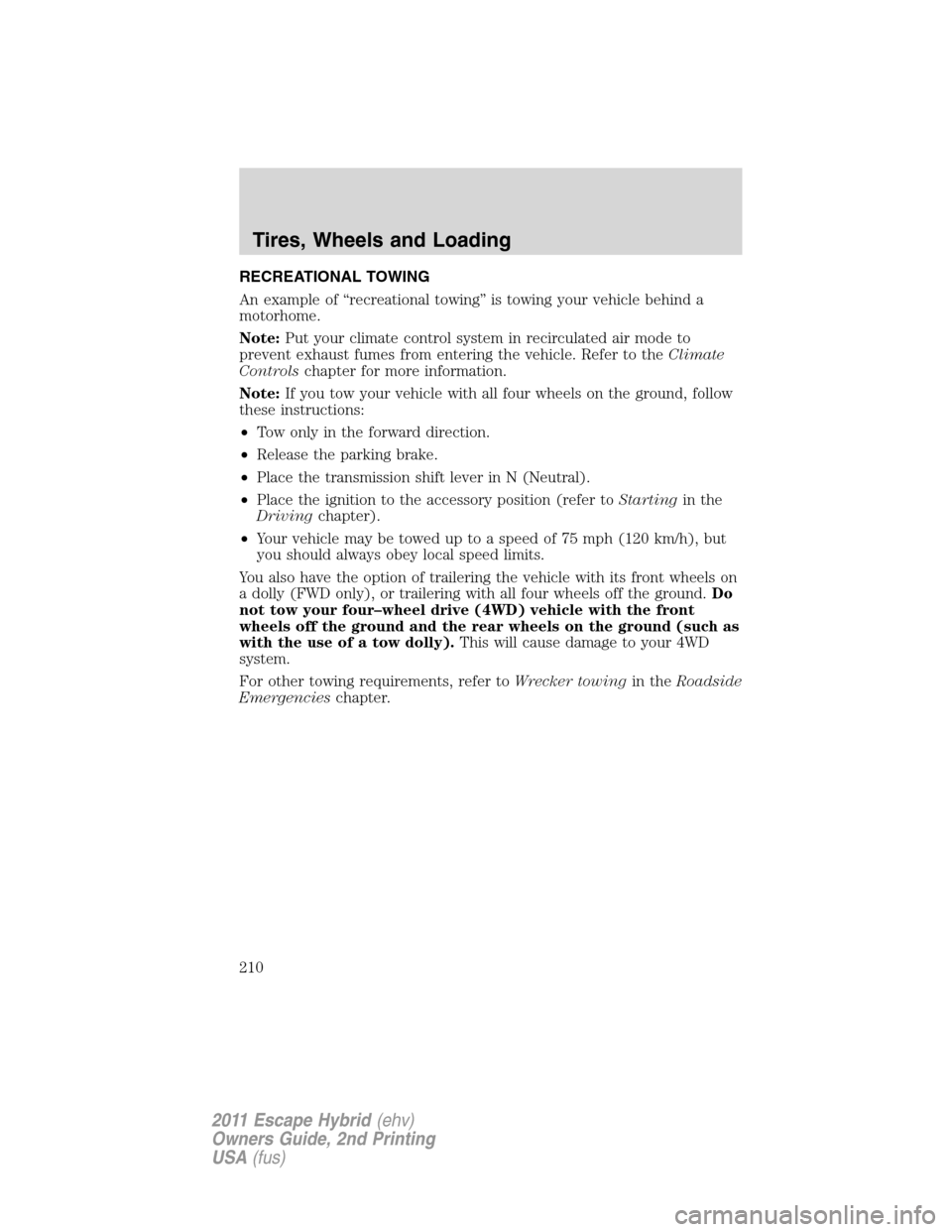
RECREATIONAL TOWING
An example of “recreational towing” is towing your vehicle behind a
motorhome.
Note:Put your climate control system in recirculated air mode to
prevent exhaust fumes from entering the vehicle. Refer to theClimate
Controlschapter for more information.
Note:If you tow your vehicle with all four wheels on the ground, follow
these instructions:
•Tow only in the forward direction.
•Release the parking brake.
•Place the transmission shift lever in N (Neutral).
•Place the ignition to the accessory position (refer toStartingin the
Drivingchapter).
•Your vehicle may be towed up to a speed of 75 mph (120 km/h), but
you should always obey local speed limits.
You also have the option of trailering the vehicle with its front wheels on
a dolly (FWD only), or trailering with all four wheels off the ground.Do
not tow your four–wheel drive (4WD) vehicle with the front
wheels off the ground and the rear wheels on the ground (such as
with the use of a tow dolly).This will cause damage to your 4WD
system.
For other towing requirements, refer toWrecker towingin theRoadside
Emergencieschapter.
Tires, Wheels and Loading
210
2011 Escape Hybrid(ehv)
Owners Guide, 2nd Printing
USA(fus)